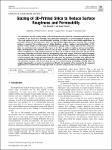Item Infomation
Full metadata record
| DC Field | Value | Language |
|---|---|---|
| dc.contributor.author | Åkerfeldt, Erika | - |
| dc.contributor.author | Thornell, Greger | - |
| dc.date.accessioned | 2023-10-06T07:05:37Z | - |
| dc.date.available | 2023-10-06T07:05:37Z | - |
| dc.date.issued | 2023 | - |
| dc.identifier.uri | https://link.springer.com/article/10.1007/s11665-023-08738-z | - |
| dc.identifier.uri | https://dlib.phenikaa-uni.edu.vn/handle/PNK/9490 | - |
| dc.description | CC-BY | vi |
| dc.description.abstract | The advantages that 3D printing brings to the development and production of customized structures make it suitable for use in the space industry, since spacecraft components are rarely produced in large series. This work explores the use of stereolithography printing of a silica resin for microfluidic applications, in particular small-scale microthrusters, where an impermeable high-temperature material with a smooth surface is required. The printing accuracy, firing shrinkage, surface roughness and permeability of 3D-printed ceramic samples were investigated. Furthermore, glazing of the ceramic material with a stoneware glaze was performed and evaluated with respect to its effect on surface roughness and gas permeability. Open microchannels with diameter down to 250 µm were obtained. However, the accuracy was poor. Surface roughness (Sa) of the unglazed material was between 2.4 and 20 µm in green state and 4.2-16 µm after firing, depending on the layer thickness and printing angle of the sample. | vi |
| dc.language.iso | en | vi |
| dc.publisher | Springer | vi |
| dc.subject | 3D-Printed Silica | vi |
| dc.subject | Permeability | vi |
| dc.title | Glazing of 3D-Printed Silica to Reduce Surface Roughness and Permeability | vi |
| dc.type | Book | vi |
| Appears in Collections | ||
| OER - Khoa học Vật liệu, Ứng dụng | ||
Files in This Item:

